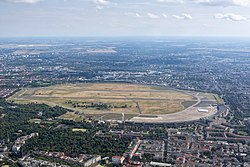
Back Tempelhof-lughawe Afrikaans مطار برلين تمبلهوف Arabic Aeropuertu de Berlín-Tempelhof AST Аэрапорт Берлін-Тэмпельгоф Byelorussian Aeroport de Berlín-Tempelhof Catalan فڕۆکەخانەی تەمپلھۆف لە بەرلین CKB Letiště Berlín-Tempelhof Czech Flughafen Berlin-Tempelhof Danish Flughafen Berlin-Tempelhof German Flughaveno Berlino-Tempelhof Esperanto
Berlin Tempelhof Airport Flughafen Berlin-Tempelhof | |||||||||||||||
|---|---|---|---|---|---|---|---|---|---|---|---|---|---|---|---|
 Aerial view of Tempelhof Airport | |||||||||||||||
| Summary | |||||||||||||||
| Airport type | Defunct | ||||||||||||||
| Owner | Institute for Federal Real Estate Federal State of Berlin[1] | ||||||||||||||
| Operator | Berlin Airports | ||||||||||||||
| Serves |
| ||||||||||||||
| Location | Tempelhof-Schöneberg, Berlin, Germany | ||||||||||||||
| Opened | 8 October 1923 | ||||||||||||||
| Closed | 30 October 2008 | ||||||||||||||
| Hub for |
| ||||||||||||||
| Elevation AMSL | 164 ft / 50 m | ||||||||||||||
| Coordinates | 52°28′25″N 013°24′06″E / 52.47361°N 13.40167°E | ||||||||||||||
| Website | www | ||||||||||||||
| Map | |||||||||||||||
 | |||||||||||||||
| Runways | |||||||||||||||
| |||||||||||||||
Berlin Tempelhof Airport (German: Flughafen Berlin-Tempelhof) (IATA: THF, ICAO: EDDI) was one of the first airports in Berlin, Germany. Situated in the south-central Berlin borough of Tempelhof-Schöneberg, the airport ceased operating in 2008 amid controversy, leaving Tegel and Schönefeld as the two main airports serving the city for another twelve years until both were replaced by Berlin Brandenburg Airport in 2020.[3]
Tempelhof was designated as an airport by the Reich Ministry of Transport on 8 October 1923. The old terminal was originally constructed in 1927. In anticipation of increasing air traffic, the Nazi government began an enormous reconstruction in the mid-1930s. While it was occasionally cited as the world's oldest operating commercial airport, the title was disputed by several other airports, and is no longer an issue since its closure.
Tempelhof was one of Europe's three iconic pre-World War II airports, the others being London's now defunct Croydon Airport and the old Paris–Le Bourget Airport. It acquired a further iconic status as the centre of the Berlin Airlift of 1948–49. One of the airport's most distinctive features is its huge, canopy-style roof extending over the apron, able to accommodate most contemporary airliners in the 1950s, 1960s and early 1970s, protecting passengers from the elements. Tempelhof Airport's main building was once among the twenty largest buildings on earth, but it also formerly contained the world's smallest duty-free shop.[4]
Tempelhof Airport closed all operations on 30 October 2008, despite the efforts of some protesters to prevent the closure.[5] A non-binding referendum was held on 27 April 2008 against the impending closure but failed due to low voter turnout. The former airfield has subsequently been used as a recreational space known as Tempelhofer Feld.[6] In September 2015, it was announced that Tempelhof would also become an emergency refugee camp.[7]
- ^ Institute for Federal Real Estate, September 2008. Page 9.
- ^ "EAD Basic – Error Page". eurocontrol.int. Retrieved 16 October 2015.
- ^ Matthies, Bernd (29 September 2020). "TXL-Schließung am 8. November: Der letzte Flug von Tegel geht mit Air France nach Paris" [Closure on November 8th: The last flight from Tegel is with Air France to Paris]. Der Tagesspiegel (in German). Retrieved 2 November 2020.
- ^ Airports International. June 1975.
- ^ Kulish, Nicholas (30 October 2008). "Crowds Bid Farewell to Airport That Saved Berlin". The New York Times. Retrieved 20 June 2017.
- ^ Fahey, Ciarán (5 March 2015). "How Berliners refused to give Tempelhof airport over to developers". The Guardian. Retrieved 1 May 2016.
- ^ Akkoc, Raziye (14 September 2015). "Refugee crisis: Europe's borders unravelling as Austria and Slovakia impose frontier controls – live". www.telegraph.co.uk. Archived from the original on 12 January 2022. Retrieved 14 September 2015.
